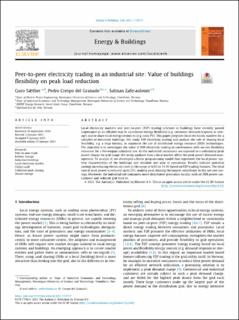| dc.contributor.author | Sæther, Guro | |
| dc.contributor.author | Crespo del Granado, Pedro | |
| dc.contributor.author | Zaferanlouei, Salman | |
| dc.date.accessioned | 2021-05-05T13:45:43Z | |
| dc.date.available | 2021-05-05T13:45:43Z | |
| dc.date.created | 2021-01-16T14:18:31Z | |
| dc.date.issued | 2021 | |
| dc.identifier.issn | 0378-7788 | |
| dc.identifier.uri | https://hdl.handle.net/11250/2753749 | |
| dc.description.abstract | Local electricity markets and peer-to-peer (P2P) trading schemes in buildings have recently gained importance as an efficient way to incentivize energy flexibility (e.g. consumer demand response or storage) and to share local energy resources (e.g. solar PV). This paper proposes local electricity markets for a complex of industrial buildings. We study P2P electricity trading and analyze the role of sharing local flexibility, e.g. a large battery, to maximise the use of distributed energy resource (DER) technologies. The objective is to investigate the value of P2P electricity trading in combination with on-site flexibility resources for a Norwegian industrial site. As the industrial consumers are exposed to a substantial peak power charge for grid usage, the study analyses how a local market affect the peak power demand management. To analyze it, we developed a linear programming model that represents the local power system characteristics of the buildings and simulate one year in operations. Results indicate potential savings on reducing electricity costs in the range of 6.8 % to 11.0 % based on P2P trading features. The total cost of peak power is reduced up to 25 %, making peak shaving the largest contributor to the net cost savings. Moreover, the industrial site consumes more distributed generation locally, with no DER power curtailment and reduced grid feed-in. © 2021 The Author(s) | en_US |
| dc.language.iso | eng | en_US |
| dc.publisher | Elsevier | en_US |
| dc.rights | Navngivelse 4.0 Internasjonal | * |
| dc.rights.uri | http://creativecommons.org/licenses/by/4.0/deed.no | * |
| dc.subject | Peer-to-peer trade | en_US |
| dc.subject | Battery storage | en_US |
| dc.subject | Industrial buildings | en_US |
| dc.subject | Local electricity market | en_US |
| dc.subject | Utility tariff | en_US |
| dc.subject | Collective peak shaving | en_US |
| dc.subject | Shared storage | en_US |
| dc.title | Peer-to-Peer electricity trading in an Industrial site: Value of buildings flexibility on peak load reduction | en_US |
| dc.type | Peer reviewed | en_US |
| dc.type | Journal article | en_US |
| dc.description.version | publishedVersion | en_US |
| dc.rights.holder | The Authors | en_US |
| dc.subject.nsi | VDP::Elkraft: 542 | en_US |
| dc.subject.nsi | VDP::Electrical power engineering: 542 | en_US |
| dc.subject.nsi | VDP::Elkraft: 542 | en_US |
| dc.subject.nsi | VDP::Electrical power engineering: 542 | en_US |
| dc.source.volume | 236 | en_US |
| dc.source.journal | Energy and Buildings | en_US |
| dc.identifier.doi | https://doi.org/10.1016/j.enbuild.2021.110737 | |
| dc.identifier.cristin | 1872517 | |
| dc.relation.project | EC/H2020/775970 | en_US |
| dc.relation.project | EC/H2020/824260 | en_US |
| dc.source.articlenumber | 110737 | en_US |
| cristin.ispublished | true | |
| cristin.fulltext | preprint | |
| cristin.fulltext | original | |
| cristin.qualitycode | 2 | |

